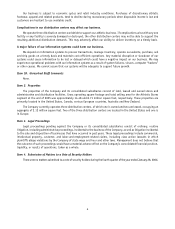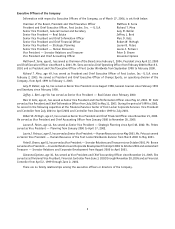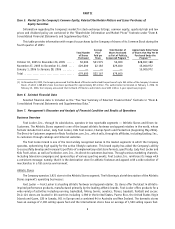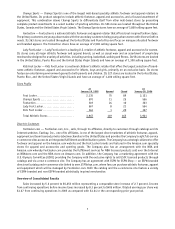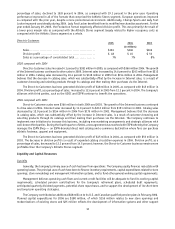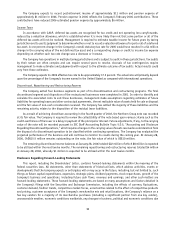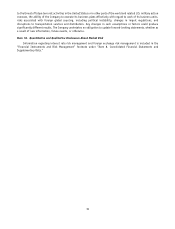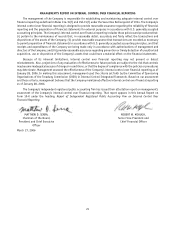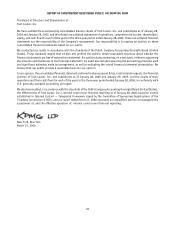Foot Locker 2005 Annual Report Download - page 28
Download and view the complete annual report
Please find page 28 of the 2005 Foot Locker annual report below. You can navigate through the pages in the report by either clicking on the pages listed below, or by using the keyword search tool below to find specific information within the annual report.
percentage of sales, declined to 18.8 percent in 2004, as compared with 19.1 percent in the prior year. Operating
performance improved in all of the formats that comprised the Athletic Stores segment. European operations improved
as compared with the prior year, despite a more promotional environment. Additionally, Champs Sports and Lady Foot
Locker improved considerably during 2004. Lady Foot Locker benefited from its modified merchandise assortment. For the
year ended January 29, 2005, the Footaction format negatively affected division profit. This was primarily the result of
a lower gross margin rate as compared with the Athletic Stores segment largely related to higher occupancy costs as
compared with the Athletic Stores segment as a whole.
Direct-to-Customers 2005 2004 2003
(in millions)
Sales........................................................ $381 $366 $366
Division profit .............................................. $ 48 $ 45 $ 53
Sales as a percentage of consolidated total ................. 7% 7% 8%
2005 compared with 2004
Direct-to-Customers sales increased 4.1 percent to $381 million in 2005, as compared with $366 million 2004. The growth
of the Internet business continued to drive sales in 2005. Internet sales increased by 14.6 percent to $243 million from $212
million in 2004. Catalog sales decreased by 10.4 percent to $138 million in 2005 from $154 million in 2004. Management
believes that the decrease in catalog sales, which was substantially offset by the increase in Internet sales, is a result of
customers browsing and selecting products through its catalogs and then making their purchases via the Internet.
The Direct-to-Customers business generated division profit of $48 million in 2005, as compared with $45 million in
2004. Division profit, as a percentage of sales, increased to 12.6 percent in 2005 from 12.3 percent in 2004. The Company’s
alliances with third parties, such as the USOC and ESPN continue to benefit the operations.
2004 compared with 2003
Direct-to-Customers sales were $366 million in both 2004 and 2003. The growth of the Internet business continued
to drive sales in 2004. Internet sales increased by 11.0 percent to $212 million from $191 million in 2003. Catalog sales
decreased by 12.0 percent to $154 million in 2004 from $175 million in 2003. Management believes that the decrease
in catalog sales, which was substantially offset by the increase in Internet sales, is a result of customers browsing and
selecting products through its catalogs and then making their purchases via the Internet. The Company continues to
implement new initiatives to increase this business, including new marketing arrangements and strategic alliances with
well-known third parties. During the fourth quarter of 2004, a new agreement was reached with ESPN whereby the Company
manages the ESPN Shop — an ESPN-branded direct mail catalog and e-commerce destination where fans can purchase
athletic footwear, apparel and equipment.
The Direct-to-Customers business generated division profit of $45 million in 2004, as compared with $53 million in
2003. The decrease in division profit is a result of expanded catalog circulation expenses in 2004. Division profit, as a
percentage of sales, decreased to 12.3 percent from 14.5 percent; however, the Direct-to-Customer business remains more
profitable than the Company’s Athletic Stores segment.
Liquidity and Capital Resources
Liquidity
Generally, the Company’s primary source of cash has been from operations. The Company usually finances real estate with
operating leases. The principal uses of cash have been to finance inventory requirements, capital expenditures related to store
openings, store remodelings and management information systems, and to fund other general working capital requirements.
Management believes operating cash flows and current credit facilities will be adequate to fund its working capital
requirements, scheduled pension contributions for the Company’s retirement plans, scheduled debt repayments,
anticipated quarterly dividend payments, potential share repurchases, and to support the development of its short-term
and long-term operating strategies.
The Company contributed an additional $68 million to its U.S. and Canadian qualified pension plans in February 2006.
Planned capital expenditures for 2006 are $180 million, of which $155 million relates to new store openings and
modernizations of existing stores and $25 million reflects the development of information systems and other support
12




